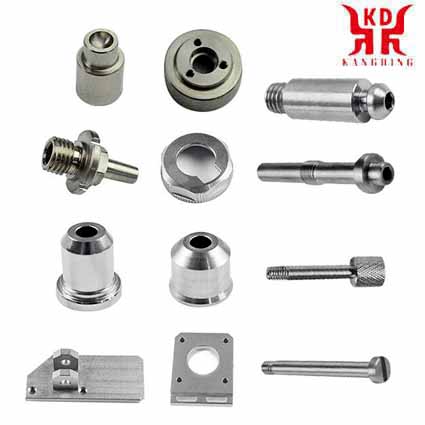Precision CNC Swiss Machining Services

Swiss CNC Machining and Turned Parts Manufacturer
Several key elements of Swiss machine turning include segmented machining, workpiece characteristics, guide bush maintenance, cutting tools, machine size, and how to avoid burrs. Swiss-style CNC lathes have excellent machining accuracy and flexibility. In addition to providing the processing performance and control advantages of traditional CNC machine tools, Swiss-style lathes also have some of their own characteristics. The efficient application of Swiss-style lathes requires a completely different method from ordinary lathe processing.The development of Swiss-type CNC machine tool technology has helped to make these machine tools widely used in medical, aerospace, automotive, electronics and general metal processing. When the ratio of length to diameter of a complex workpiece will deviate during turning, the Swiss machine tool can be made effective by using a slidable headstock capable of feeding on the Z axis.
If you need to manufacture complex parts by a reliable precision CNC parts manufacturer, you can rely on Swiss CNC machining services in KANGDING. This is a top CNC machining company in China, specializing in CNC services and precision hardware production for decades. And has the ability to provide Swiss CNC machining services for the manufacturing needs of various industries around the world with the latest Swiss turning processing technology. With advanced Swiss lathes and Swiss machines, as well as other manufacturing facilities, our experienced experts and technicians can provide you with the most cost-effective solutions. The highest quality Swiss machine turned parts can be produced according to industry standards and customer requirements. From 5-axis milling services to Swiss CNC machining services, from Swiss CNC turning to wire cutting, no matter what type of CNC components you need, our team will help you get close to the standard. Processing materials include stainless steel, aluminum, copper, and titanium, magnesium and so on. Welcome to contact us to get a free quote quickly.

Why choose Swiss machining services?
Custom CNC Swiss machine turning parts can be produced quickly and efficiently, suitable for high-volume production of small parts.High speed and reliability will change quickly, and increase productivity will shorten the production cycle.
The width tolerance and high precision can be achieved for the complex parts project of precision Swiss CNC machining.
Due to the application of tools and sub-spindles, secondary processing is reduced, speeding up the entire process.
High-quality and high-end materials, careful operation, strict inspection of the entire processing process, and product quality testing.
Swiss CNC lathe service capabilities
Our CNC Swiss machining service is the choice of various industries. We have the ability to bring the best precision Swiss machined parts to your exact needs to meet the following materials.Material: stainless steel (303, 304, 316, 416, 420, etc.), carbon steel (1018, 1045, etc.), aluminum (6061, 6063, 7075, etc.), brass, copper, plastic, etc.
Industries: medical instruments, surgical tools, optical measuring equipment, computer accessories, military and defense, watch industries, etc.

What is Swiss machine turning?
The Swiss lathe is a type of lathe in which the collet or holding mechanism is recessed behind the guide bushing. Swiss lathes are also known as Swiss turning centers, Swiss automatic lathes or Swiss screw machines. The difference between a Swiss lathe and a traditional lathe is that the collet holding the bar is not directly exposed under the mold and bed of the lathe. This type of configuration gives the machine tool certain advantages over traditional lathes.Generally, Swiss machining refers to a precision manufacturing process, where components are produced on Swiss machines, and the parts rotate and move radially. Due to the unique design of Swiss machines, CNC Swiss turning services allow simultaneous execution of multiple operations in several areas in a short period of time. Therefore, the speed of machining is greatly improved. This type of machining technology is often used in small precision CNC rotating parts projects.
The advantage of Swiss lathes over traditional lathes is mainly due to the use of guide bushings. The purpose of the guide bushing is to provide additional support for the material while the part is being turned. The guide bushing tightly but not tightly surrounds the bar stock. The function of supporting the bar and the guide bushing is similar to that of being fixed on the carriage of a traditional lathe.
Swiss-style lathes usually have better tolerances on the parts because the turning operations are performed in the immediate vicinity of the guide bushing. The guide bushing provides rigidity to the turned part, because after leaving the bushing until the turning tool is engaged, only a few blanks are exposed. With the rigidity of the blanks imparted by the guide bushings, these machines are particularly suitable for maintaining tight tolerances. Another benefit of the Swiss lathe is that it can turn small diameter parts or parts with a large aspect ratio. Due to the juxtaposition of the tool/guide bushing, tool jitter can usually be minimized.
There are two types of Swiss lathe machines. Mechanical lathes use cams, gear systems and mechanical linkages to move the headstock and manipulate collets and tools. These types of machines have been replaced by computer numerical control (CNC) Swiss lathes in many places.

Swiss CNC lathes will utilize many computer-controlled components. During machine operation, many of these components can be adjusted. The advantage of the CNC Swiss lathe is that by adding a computer and its controlled components, the accuracy of the traditional machine tool can be maintained while improving the function of the machine tool.
Modern types of CNC Swiss lathes may include multi-spindle and powered auxiliary tools, moving tailstocks or auxiliary spindles. Depending on the required part configuration, some Swiss lathes have the ability to turn and machine complete parts. This eliminates the need for secondary operations.
The disadvantage of all Swiss lathes is bar residue. These are generally longer than traditional types of lathes and are generally considered waste products. The configuration of the chuck and guide bushing in the machine will cause a large amount of residue to remain.





